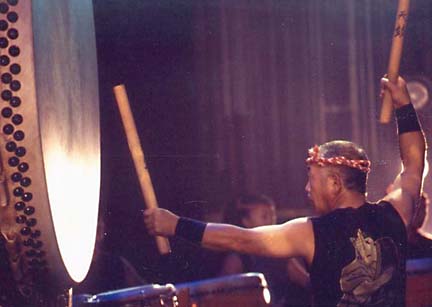

|
Feeling the beat
Taiko drummers gather in isles
|
|
— ADVERTISEMENT —
|
||||||||
 |
||||||||
Feeling the beatTaiko drummers gather in isles
| ||||||||
As president of Hawaii International Taiko, a conglomeration of various taiko groups from across the state, Chong and his one-year-old corporation have summoned international taiko experts and performers to Oahu for a three-day cultural exchange that started yesterday and runs through Sunday. An avid supporter of taiko for years, Chong is thrilled with the prospect of tomorrow night's "International Stars of Taiko In Concert" at the Waikiki Shell, the highlight of the convention.
"We wanted to create an event that would bring taiko players from around the world here to do workshops, share their experiences and styles of playing and bring the taiko community together," he states.

|
The centuries-old art, which had a place in village life, on the battlefield and in religious ceremony in ancient Japan, has not only survived, but flourished and spread worldwide. Some 8,000 taiko groups are said to exist worldwide. By Chong's estimates, the Aloha State is home to perhaps 30 taiko performance groups, up to as many as 100, if you count groups affiliated with local churches and temples.
This week's convention involves 300 participants and volunteers, while the festival at the 8,400-capacity Waikiki Shell features a number of world-renowned, award-winning taiko groups from Japan, North America and Hawaii, and a number of food and merchandise booths.
One of the returning groups, Amanojaku, features the world's top female taiko drummers in a mixed ensemble. Known for their unique and impressively staged way of infusing modern and Western elements of percussion with taiko, they're one of the premiere ensembles that have toured the world over.
There are many reasons why Chong believes the event will be appreciated by attendees.
"First, people get to see this real Japanese art form," he remarks. "Secondly, to watch people practice is the best part because you see their true passion for perfection in their art. And lastly, the exchanging and bonding that goes on when the Japanese, American and Hawaiian groups learn from each other are another great benefit that's not always seen. When you go to a taiko concert, you don't just hear taiko. In a lot of ways, you feel its strength, too."
